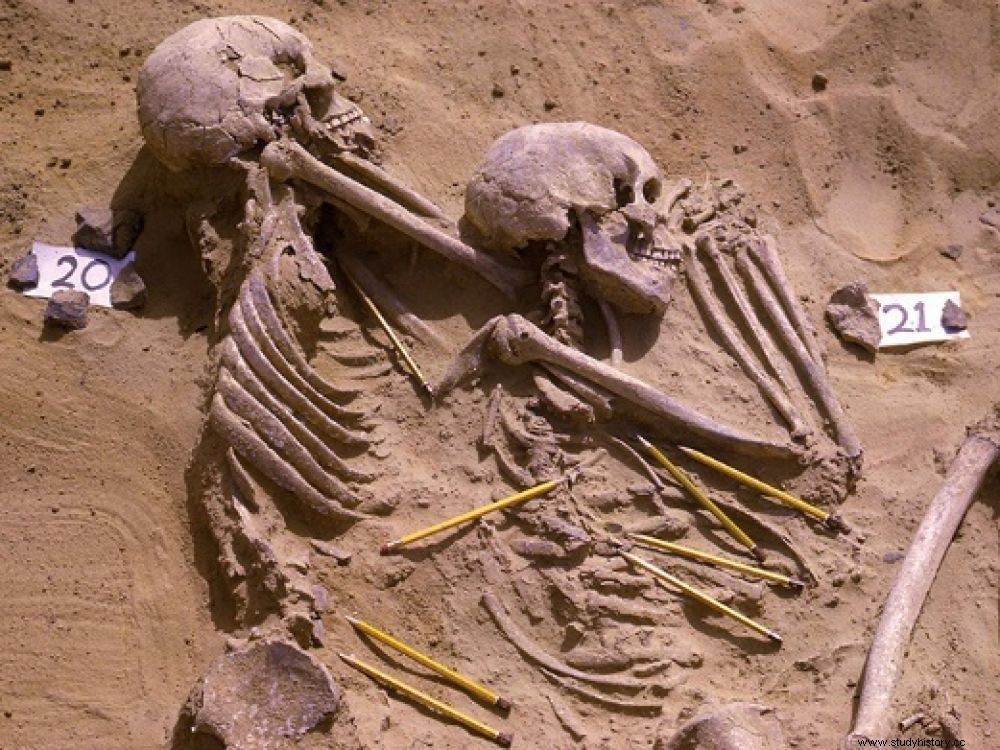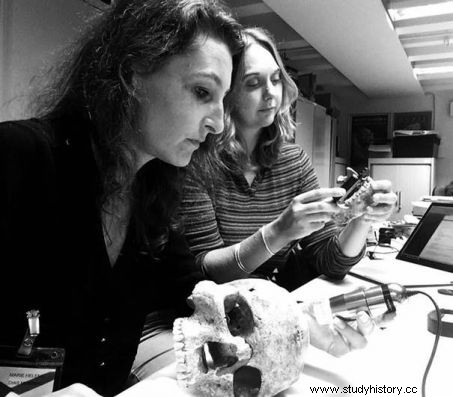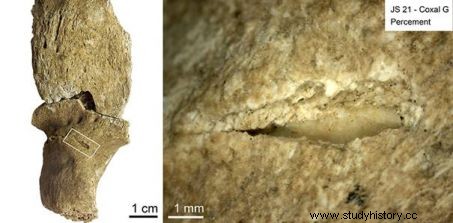A new examination of skeletons found in southern Egypt indicates that the first episodes of violence would not have been exceptional events. For specialists, the sharing of the same environment between several cultural groups would have favored conflicts.

Archival photograph illustrating the double tomb of individuals JS 20 and JS 21 with the indication by the pencils of the position of the associated lithic artefacts.
On the border between Egypt and Sudan, the site of Jebel Sahaba is home to the oldest cemetery in the Nile Valley. But what especially intrigued archaeologists when it was discovered in 1964 were the traces of wounds discovered on the bones, witnesses of armed clashes between human beings. Until then, scientists believed that a single battle was the cause of the victims found during excavations. But a study conducted by a French team and published on May 27, 2021 in the journal Scientific Reports challenges this scenario.
Thanks to new analyzes of the bone remains, the article concludes rather to a series of regular altercations. Of the 61 individuals exhumed, two-thirds have injuries caused during combat, often by projectiles. The site, 13,400 to 18,600 years old, dates from the Upper Pleistocene, the end of the Palaeolithic.
Read the wounds on the bones
What makes the researchers say that the inhabitants of the region experienced successive episodes of violence are the healed wounds detected on part of the bones.
On the border between Egypt and Sudan, the site of Jebel Sahaba is home to the oldest cemetery in the Nile Valley. But what especially intrigued archaeologists when it was discovered in 1964 were the traces of wounds discovered on the bones, witnesses of armed clashes between human beings. Until then, scientists believed that a single battle was the cause of the victims found during excavations. But a study conducted by a French team and published on May 27, 2021 in the journal Scientific Reports challenges this scenario.
Thanks to new analyzes of the bone remains, the article concludes rather to a series of regular altercations. Of the 61 individuals exhumed, two-thirds have injuries caused during combat, often by projectiles. The site, 13,400 to 18,600 years old, dates from the Upper Pleistocene, the end of the Palaeolithic.
Read the wounds on the bones
What makes the researchers say that the inhabitants of the region have experienced successive episodes of violence are the healed wounds detected on part of the bones. In particular, a quarter of the bodies present both lesions that have resorbed and others that have not had time to heal. Moreover, examination of the site shows that the bodies were not all buried at once. "The re-study of the bones has made it possible to identify new lesions. In particular, microscopic flint shards around which the wounds have healed", reports Isabelle Crèvecoeur, paleoanthropologist at the CNRS and first author of the study. For more than six years, the researcher and her colleague Marie‑Hélène Dias‑Meirinho, from the University of Toulouse Jean Jaurès, traveled regularly to London to access the collection of skeletons now at the British Museum.

Study of human remains from Jebel Sahaba in the Egypt and Sudan Department of the British Museum (London). Microscopic analysis of bone lesions and anthropological study by Marie-Hélène Dias-Meirinho (left) and Isabelle Crevecoeur (right). © Marie-Hélène Dias-Meirinho
Long-term work to reassess them with more modern techniques than in the 1960s. In particular, microscopic analysis and the contribution of experimental archeology (notably flint weapon hunting experiments on animals) help determine the origin of injuries more precisely. This allowed them to differentiate the penetration marks of spears or arrows from other cut marks, such as those produced during the funeral preparation of the bodies. The hundred listed lesions thus help to reconstruct the events that took place in the region. More than rare intense episodes of interpersonal violence, the study envisions frequent "skirmishes, raids or ambushes" between different groups. But what could have caused these fights?

Trace of a projectile impact with a lithic flake lodged in the opening at the level of the posterior surface of the left coxal bone of individual JS 21. © Isabelle Crevecoeur / Marie-Hélène Dias-Meirinho
Environmental and cultural conflicts
The end of the Pleistocene corresponds to a period of climatic and environmental changes, in particular the aridification of the regions around the Nile. At that time, hunter-gatherers settled on the banks of the river. "Faced with aridity, populations have been forced to come together, explains Isabelle Crèvecoeur. We don't have an extremely rich environment, other than access to resources from the Nile." The population density in a restricted area and the competition for food would be one of the causes of conflicts. But other tensions are added. “There would also have been cultural issues. It is observed that each group had different lithic techniques, for tools that have the same function. They were culturally distinct groups, which may have fostered greater rivalry ." More than 10,000 years ago, humanity was already solving its problems through violence.
By Edwyn Guérineau
